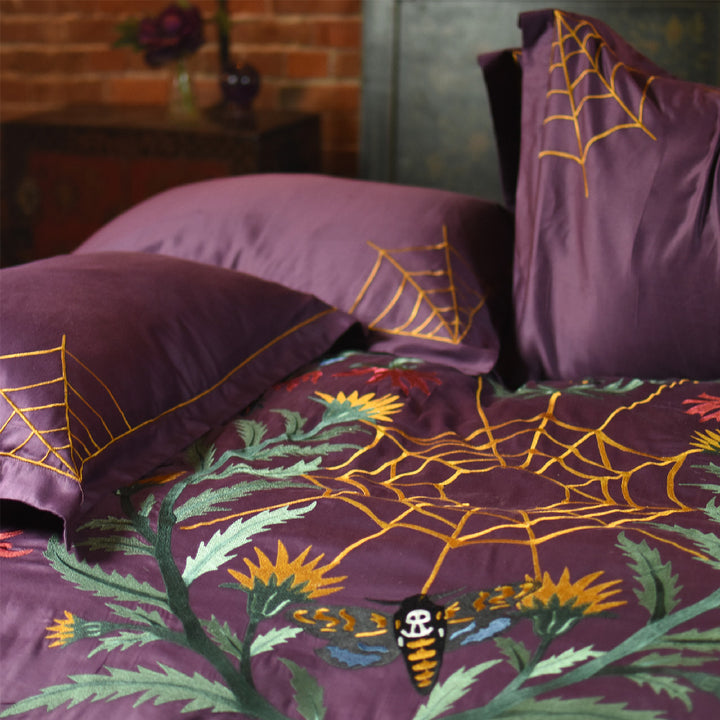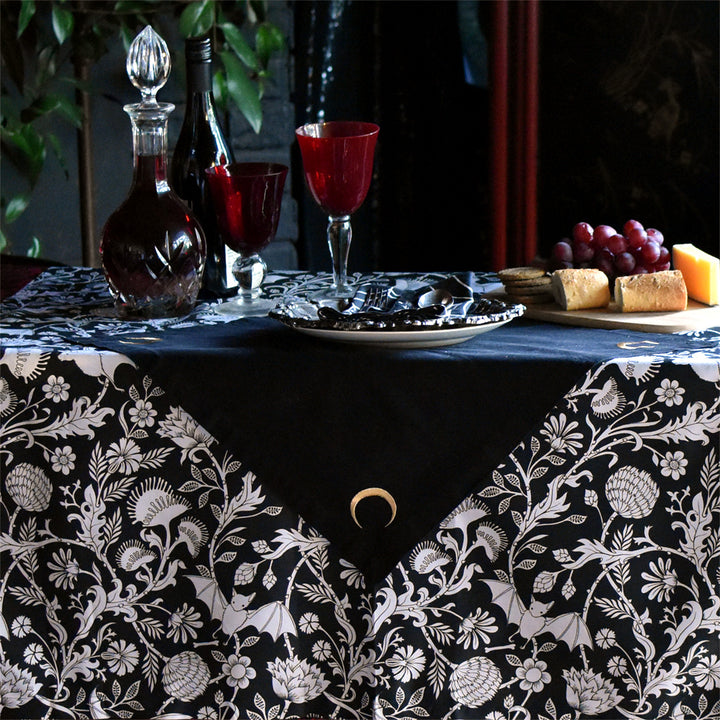Polyester vs. Cotton

Definition: Polyester and cotton represent two distinct origins in textile history. Cotton is a natural fiber, collected from the seed hairs of the Gossypium plant and spun into thread. Revered for its softness and breathability, cotton has been used for centuries in garments and interior design. Polyester entered the scene in the 20th century, introducing a modern alternative to plant-based textiles and redefining how we think about durability and function.
Characteristics:
- Created through polymerization, polyester begins as a reaction between petroleum-based compounds. The result is a plastic-based fiber that resists wrinkles, holds vivid dyes and maintains its shape after repeated use.
- Cotton, by comparison, absorbs moisture easily and allows air to pass through its threads. Its softness, breathability, and hypoallergenic nature make it ideal for textiles that touch skin or layer naturally into relaxed, atmospheric spaces.
Examples:
- Spider Web Lace Curtain in Black: Made from cotton, this curtain creates a soft yet shadowy silhouette, pairing a soft look with gothic intricacy.
- Love Bound Heart Damask Duvet Cover in Rose: This 100% cotton duvet cover features a vintage-inspired damask design with rich, flirty hues.
- Gold Velvet Curtain: These luminous curtains shimmer with rich texture. Crafted from plant-based viscose velvet and anchored by a cotton backing, these curtains feature sexy tasseled edges that bring theatrical flair to rooms.
Interesting Fact: Cotton has been used for over 7,000 years, with remnants found in the Indus Valley, dating back to 5000 BCE. Ancient civilizations spun and wove cotton by hand to create garments and household fabrics. However, polyester emerged during the early 1940s and quickly revolutionized textile manufacturing. With its resistance to wrinkles and minimal care requirements, polyester became a staple of postwar design.
What Lies Beneath: Characteristics of Cotton and Polyester
Polyester and cotton offer two distinct approaches to fabric construction. One is born from industrial precision, the other from the natural world. Their properties influence everything from texture and structure to comfort and long-term wear, making them foundational to alternative interiors.
Polyester
Polyester is a synthetic material produced through polymerization, a process that fuses petroleum-based compounds into long, durable strands. These strands form a fabric known for strength, shape retention, and wrinkle resistance. Once dyed, polyester locks in color with intensity to support statement textiles that don’t lose their impact over time. However, its synthetic feel and limited airflow often make it less suited for intimate or restful spaces.
Cotton
Cotton grows from the seed hairs of the Gossypium plant and is spun into a soft, breathable textile. Air moves easily through its fibers, allowing for comfort in lightweight and heavier applications. This adaptability gives cotton a quiet confidence in spaces where ambiance matters. In some designs, cotton serves as the base layer beneath more decorative surfaces. Our Black Velvet Curtain features a cotton backing that balances the velvet’s richness.
Environmental Impact of Cotton and Polyester
Every fabric leaves a trace, not only in a room’s design but also in the world beyond it. The environmental impact of cotton and polyester reveals two very different paths, each shaped by how the material is made, used, and discarded.
Cotton
Cotton begins in the earth—rooted, rhythmic, and responsive. While conventional farming can draw heavily on water and rely on chemical treatments, the story doesn’t end there. When grown with care, cotton’s growing methods, like crop rotation and water-conscious practices, offer a path toward sustainability. Additionally, it’s plant-based, biodegradable, and leaves less of a long-term environmental burden. In spaces where design carries deeper meaning, cotton weaves beauty and responsibility into every thread.
Polyester
Polyester is created through petroleum-based manufacturing. While the production process consumes less water, the material introduces a different challenge. As polyester fabrics break down, they shed microplastic fibers. These fibers often move through water systems and remain in the environment long after the textile has served its purpose. The durability that makes polyester appealing in design also raises concerns about waste and pollution.
Overall, both materials raise important questions about sustainability. Organic cotton and recycled polyester offer more responsible alternatives as we move towards a more sustainably-aware society. Choosing fabrics with care becomes part of a broader shift toward intentional interiors that look good, feel right, and leave a lighter footprint behind.
Pros and Cons of Polyester
Polyester brings a structured presence to interiors that favor bold silhouettes and low-maintenance fabrics. This synthetic fiber stands up to wear, keeps its color, and offers longevity.
Pros of Polyester
- Durable and Low Maintenance: Polyester is built to last. Polyester holds its shape over time and resists fading, stretching, and shrinking.
- Wrinkle-Resistant: The fabric maintains a smooth, polished appearance straight out of the wash, perfect for anyone who wants crisp lines without reaching for an iron.
- Quick-Drying: Polyester dries more quickly than most natural fabrics. This makes it ideal for frequently used pieces like bedding or curtains that bounce back fast between washes.
Cons of Polyester
- Less Breathable: Polyester tends to trap heat and doesn’t circulate air as well as natural fibers.
- Static-Prone: The synthetic construction can create friction that leads to static cling, especially in dry environments.
- Potential Environmental Concerns: Polyester is petroleum-based and non-biodegradable. As it breaks down, it sheds microplastics that linger in water systems. While recycled versions exist, their impact often extends far beyond the home.
Pros and Cons of Cotton
Cotton delivers comfort with texture. As a natural fiber, it layers easily into interiors that value softness, breathability, and a grounded aesthetic. Its familiar feel meets versatility across both relaxed and expressive spaces.
Pros of Cotton
- Breathability to Match Your Tempo: Cotton allows air to flow through its threads, helping regulate temperature and keeping fabrics feeling fresh. It works well in bedding or warm climates where ventilation matters.
- Lasting Strength and Softness: The fibers hold up to repeated washing without losing their tactile appeal. Medium and heavyweight cotton retain structure while staying gentle on the skin.
- Skin-Sensitive Seduction: Free from synthetic irritants, cotton offers a clean choice for sensitive skin and extended contact, especially in sleepwear and bedding worn or wrapped around the body.
Cons of Cotton
- Wrinkle Woes: Cotton creases easily, especially when air-dried. A quick press with a steamer or choosing a cotton blend helps keep the fabric smooth.
- Fade to Grey: Repeated laundering can dull rich tones or prints. Cold washes, gentle detergents, and low-heat drying extend the life of cotton’s visual depth.
Read more:
- How to Create a Romantic Bedroom: Design Tips for An Intimate Space
- How To Achieve A Timeless Gothic Interior Design In Your Home
- Everything You Need To Know About Bamboo Sheets And Their Benefits
Frequently Asked Questions About Polyester vs Cotton
Is cotton or polyester better for people with sensitive skin?
Cotton brings a natural softness that is gentle on sensitive skin. Its breathable weave reduces irritation and keeps things cool, even on long nights spent tangled in sheets. Polyester, while durable, can feel harsher and less forgiving when comfort takes priority.
Which fabric is more wrinkle-resistant, polyester or cotton?
Polyester takes the crown when it comes to staying smooth, but that sleekness comes at the cost of breathability. This synthetic fiber resists creasing, so your bedding or curtains hold their structure without extra effort. For those who crave softness over stiffness, a quick steam is a small price for a more grounded fabric like cotton.
What are the hypoallergenic differences between polyester and cotton?
Cotton keeps things cleaner by nature. The breathable fiber creates less buildup, which makes it a better choice for those with allergies or sensitive skin. Polyester has a tighter weave that can cling to dust and debris without frequent washing.
Does polyester or cotton hold dye better?
Polyester locks in color like a pro. However, cotton holds pigment more gently, fading over time like pages in a well-read book. To preserve cotton’s vibrant hues, wash the fabric in cool, gentle cycles, and opt for more natural drying methods.
Is polyester or cotton more prone to shrinking?
Cotton shifts with heat, but it’s predictable and easy to manage. Lower temperatures and mindful drying help it stay true. Polyester may resist shrinking, but what it saves in form, it often sacrifices in feel.
Is polyester or cotton easier to care for?
Polyester keeps maintenance low. It resists wrinkles, dries fast, and holds its shape without much oversight. Cotton needs a bit more love like cooler cycles, gentle detergents, and the occasional press, but don’t let that additional care scare you away from cotton’s plentiful benefits.
How does the weight of polyester compare to cotton?
Polyester tends to feel light, sometimes even hollow. Cotton, by contrast, carries presence, draping a room with intention and warmth. For interiors that feel lived-in, layered, and a little spellbound, cotton brings the weight that matters.










































Leave a comment